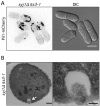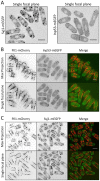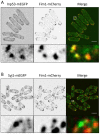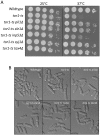A Pil1-Sle1-Syj1-Tax4 functional pathway links eisosomes with PI(4,5)P2 regulation
- PMID: 24434583
- PMCID: PMC3953819
- DOI: 10.1242/jcs.143545
A Pil1-Sle1-Syj1-Tax4 functional pathway links eisosomes with PI(4,5)P2 regulation
Abstract
Stable compartments of the plasma membrane promote a wide range of cellular functions. In yeast cells, cytosolic structures called eisosomes generate prominent cortical invaginations of unknown function. Through a series of genetic screens in fission yeast, we found that the eisosome proteins Pil1 and Sle1 function with the synaptojanin-like lipid phosphatase Syj1 and its ligand Tax4. This genetic pathway connects eisosome function with the hydrolysis of phosphatidylinositol (4,5)-bisphosphate [PI(4,5)P2] in cells. Defects in PI(4,5)P2 regulation led to eisosome defects, and we found that the core eisosome protein Pil1 can bind to and tubulate liposomes containing PI(4,5)P2. Mutations in components of the Pil1-Sle1-Syj1-Tax4 pathway suppress the growth and morphology defects of TORC2 mutants, indicating that eisosome-dependent regulation of PI(4,5)P2 feeds into signal transduction pathways. We propose that the geometry of membrane invaginations generates spatial and temporal signals for lipid-mediated signaling events in cells.
Keywords: Eisosome; PI(4,5)P2; Synaptojanin; TORC2.
Figures








Similar articles
-
Eisosomes Regulate Phosphatidylinositol 4,5-Bisphosphate (PI(4,5)P2) Cortical Clusters and Mitogen-activated Protein (MAP) Kinase Signaling upon Osmotic Stress.J Biol Chem. 2015 Oct 23;290(43):25960-73. doi: 10.1074/jbc.M115.674192. Epub 2015 Sep 10. J Biol Chem. 2015. PMID: 26359496 Free PMC article.
-
TORC2 and eisosomes are spatially interdependent, requiring optimal level of phosphatidylinositol 4, 5-bisphosphate for their integrity.J Biosci. 2015 Jun;40(2):299-311. doi: 10.1007/s12038-015-9526-4. J Biosci. 2015. PMID: 25963258
-
Seg1 controls eisosome assembly and shape.J Cell Biol. 2012 Aug 6;198(3):405-20. doi: 10.1083/jcb.201202097. J Cell Biol. 2012. PMID: 22869600 Free PMC article.
-
Insights into eisosome assembly and organization.J Biosci. 2012 Jun;37(2):295-500. doi: 10.1007/s12038-012-9206-6. J Biosci. 2012. PMID: 22581335 Review.
-
MCC/Eisosomes Regulate Cell Wall Synthesis and Stress Responses in Fungi.J Fungi (Basel). 2017 Nov 3;3(4):61. doi: 10.3390/jof3040061. J Fungi (Basel). 2017. PMID: 29371577 Free PMC article. Review.
Cited by
-
Plasma Membrane MCC/Eisosome Domains Promote Stress Resistance in Fungi.Microbiol Mol Biol Rev. 2020 Sep 16;84(4):e00063-19. doi: 10.1128/MMBR.00063-19. Print 2020 Nov 18. Microbiol Mol Biol Rev. 2020. PMID: 32938742 Free PMC article. Review.
-
High-Throughput Quantitative Genetic Interaction Mapping in the Fission Yeast Schizosaccharomyces pombe.Cold Spring Harb Protoc. 2018 Feb 1;2018(2):10.1101/pdb.top079905. doi: 10.1101/pdb.top079905. Cold Spring Harb Protoc. 2018. PMID: 28733404 Free PMC article.
-
Eisosomes Regulate Phosphatidylinositol 4,5-Bisphosphate (PI(4,5)P2) Cortical Clusters and Mitogen-activated Protein (MAP) Kinase Signaling upon Osmotic Stress.J Biol Chem. 2015 Oct 23;290(43):25960-73. doi: 10.1074/jbc.M115.674192. Epub 2015 Sep 10. J Biol Chem. 2015. PMID: 26359496 Free PMC article.
-
Cryo-EM architecture of a near-native stretch-sensitive membrane microdomain.Nature. 2024 Aug;632(8025):664-671. doi: 10.1038/s41586-024-07720-6. Epub 2024 Jul 24. Nature. 2024. PMID: 39048819 Free PMC article.
-
Microdomain Protein Nce102 Is a Local Sensor of Plasma Membrane Sphingolipid Balance.Microbiol Spectr. 2022 Aug 31;10(4):e0196122. doi: 10.1128/spectrum.01961-22. Epub 2022 Jun 27. Microbiol Spectr. 2022. PMID: 35758748 Free PMC article.
References
-
- Aguilar P. S., Fröhlich F., Rehman M., Shales M., Ulitsky I., Olivera-Couto A., Braberg H., Shamir R., Walter P., Mann M. et al. (2010). A plasma-membrane E-MAP reveals links of the eisosome with sphingolipid metabolism and endosomal trafficking. Nat. Struct. Mol. Biol. 17, 901–908 10.1038/nsmb.1829 - DOI - PMC - PubMed
-
- Bähler J., Wu J. Q., Longtine M. S., Shah N. G., McKenzie A., 3rd, Steever A. B., Wach A., Philippsen P., Pringle J. R. (1998). Heterologous modules for efficient and versatile PCR-based gene targeting in Schizosaccharomyces pombe. Yeast 14, 943–951 10.1002/(SICI)1097-0061(199807)14:10<943::AID-YEA292>3.0.CO;2-Y - DOI - PubMed
Publication types
MeSH terms
Substances
Grants and funding
LinkOut - more resources
Full Text Sources
Other Literature Sources
Research Materials
Miscellaneous

